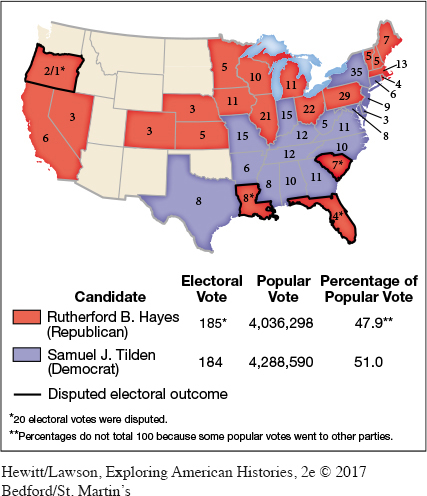The Presidential Compromise of 1876
The presidential election of 1876 set in motion events that officially brought Reconstruction to an end. The Republicans nominated the governor of Ohio, Rutherford B. Hayes, who was chosen partly because he was untainted by the corruption that plagued the Grant administration. The Democrats selected their own anticorruption crusader, Governor Samuel J. Tilden of New York.
The outcome of the election depended on twenty disputed electoral votes, nineteen from the South and one from Oregon. Tilden won 51 percent of the popular vote, but Reconstruction political battles in Florida, Louisiana, and South Carolina put the election up for grabs. In each of these states, the outgoing Republican administration certified Hayes as the winner, while the incoming Democratic regime declared for Tilden.
The Constitution assigns Congress the task of counting and certifying the electoral votes submitted by the states. Normally, this is a mere formality, but 1876 was different. Democrats controlled the House, Republicans controlled the Senate, and neither branch would budge on which votes to count. Hayes needed all twenty for victory; Tilden needed only one. To break the logjam, Congress created a fifteen-member Joint Electoral Commission, composed of seven Democrats, seven Republicans, and one independent. Ultimately, a majority voted to count all twenty votes for the Republican Hayes, making him president (Map 14.2).

Still, Congress had to ratify this count, and disgruntled southern Democrats in the Senate threatened a filibuster—unlimited debate—to block certification of Hayes. With the March 4, 1877, date for the presidential inauguration creeping perilously close and no winner officially declared, behind-the-scenes negotiations finally settled the controversy. A series of meetings between Hayes supporters and southern Democrats led to a bargain. According to the agreement, Democrats would support Hayes in exchange for the president appointing a Southerner to his cabinet, withdrawing the last federal troops from the South, and endorsing construction of a transcontinental railroad through the South. This compromise of 1877 averted a crisis over presidential succession, underscored increased southern Democratic influence within Congress, and marked the end of strong federal protections for African Americans in the South.
REVIEW & RELATE
Why did northern interest in Reconstruction wane in the 1870s?
What common values and beliefs among white Americans were reflected in the compromise of 1877?
Exploring American HistoriesPrinted Page 473
Exploring American Histories Value EditionPrinted Page 349
Chapter Timeline